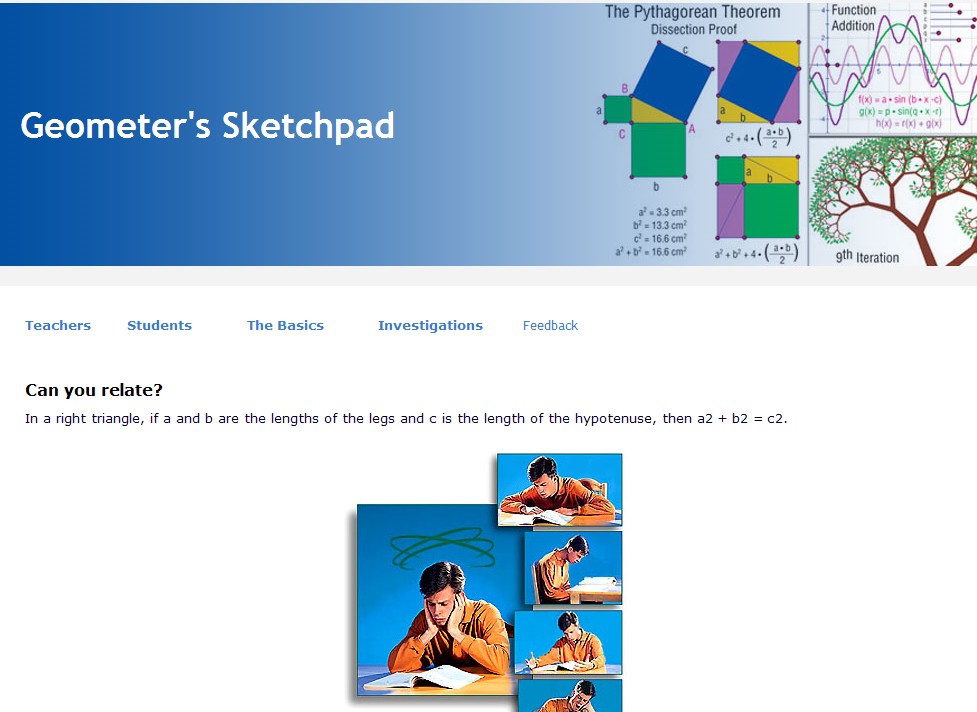Standard
Processes: Understand processes such as change, design, development, and learning.
Artifact Context
Spring 2008 EDTEC544
Geometer's Sketchpad Workshop (GSP)
Individual Project

Link to Standard
Often, the process of change leads to design and development projects. I became an agent of change during a one-semester, high school geometry teaching assignment. The mathematics teachers at the school relied pencil-and-paper as the media for instruction and student assignments. Technology integration was absent from all aspects of student instruction. After creating and delivering several computer-assisted activities with my own students, I designed and developed a training workshop and web site filled with instructor resources, centered on the Geometer's Sketchpad software. My goal was to be a catalyst for pedagogical and perceptual change among my fellow math teachers.
The process of design and development derive from information revealed in analysis. To inform the processes involved with change, I conducted a study centering on:
- Identification of barriers to use of GSP software
- Discovery of training needs
- Derivation of an instructional/training system
Using data to inform the design ensured that instruction aligned directly to the audience's characteristics and included the tasks relating to my overarching goal. My analysis yielded data , leading to the specific design elements in the table below.
Analysis | Data | |
Audience Analysis | Misconception
that GSP's functionality is limited to modeling geometry-specific concepts | Tailored
instructional system correlated to the audience's characteristics |
Interview | Reservation
process and procedures | Used to
write workshop objectives, practice, and assessment |
Function Analysis | Delineation
of the steps a teacher will perform to facilitate a mathematics lesson that
incorporates a GSP activity and receive an electronic deliverable | The foundation of the workshop. Each task is represented in the workshop's objectives |
The development process encompasses the mechanics of the work specified in the design phase (Branch & Gustafson, 2007). This is the phase when web development, graphic design, and creativity converge to bring instructional design concepts to life. By the time a design document reaches the developer's hands, it is thoroughly vetted. Developers must trust the design document to guide development of the instructional materials. Failing to remain true to the designer's roadmap risks tainting the instructional effort. For this reason, development often feels like the easiest part of instructional design for me. I can relax, trust in the work I've completed thus far, and concentrate on layout, media selection, and so on. Web site creation tools, which provide development tools such as widgets and visual editors, allow individuals to develop web-based instruction with relative ease. Depending on the functionality I require, I may choose to use such tools or web authoring tools like Adobe's Dream Weaver.
Challenges and Opportunities
Although I was not able to get on the professional development schedule toformally deliver this workshop, the greatest barrier to change was the teachers' attitudes toward change. The average length of time in the faculty for teachers at this school is eight years. Teachers had entire course's instructional plans mapped out and had negative feelings toward the extra work new lesson development requires. I designed and developed to support a change in attitude, however, I feel that further research on specific techniques is necessary on my part to maximize my effectiveness in this area. My efforts were successful with two staff members who stated that they would incorporate GSP activities in their classrooms the following year.
This was my first experience teaching high school level geometry and using Geometer's Sketchpad. It was challenging to familiarize myself with the software's functionality in math courses other than the one I was currently teaching. The substantial documentation and lesson resources available from the publisher and user community shortened my learning curve. The challenge morphed into an opportunity as I learned about the versatile nature of the software.
Professional and Personal Growth
This project allowed me to practice common tasks in the instructional design field and to address common instructional issues as well. The authenticity of the setting offered first-hand experience with issues that I'm sure to encounter again. I have a knowledge base to build upon in future efforts. Experience and knowledge are equally important in the field of instructional design and technology. I gained both in the change, design, and development efforts within this project.
References
Branch, R., & Gustafson, K.L., (2005). Trends and Issues in Instructional Design and Technology (2nd ed.). Upper Saddle River NJ: Merrill/Prentice-Hall.
The Buck Institute for Education. (2003). Project based learning: A guide to standards-focused project based learning for middle and high school teachers (2nd, Ed.). Oakland, CA: Wilsted & Taylor